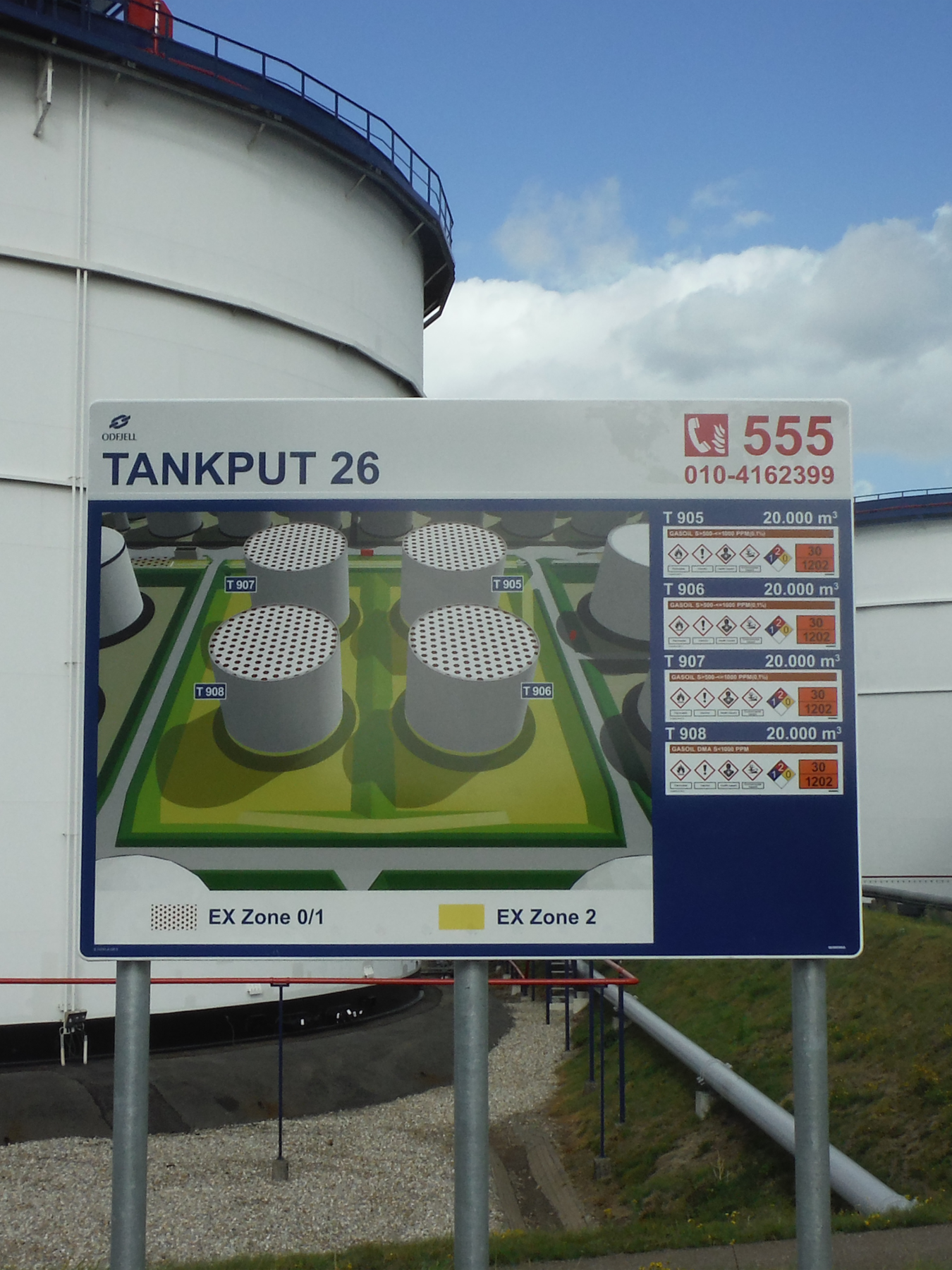Pipe Marking
Pipe marking for optimal identification of your processes
Tank marking is a marking which indicates the capacity, content and any hazard characteristics of the substance stored in a storage tank. Tank markings often have a legal basis and are therefore part of a safety information system. Tank markings contain at least the 3 core elements, the medium name, hazard symbols and GHS pictograms and a tank identification such as a tank number or name.
Tank safety information may further include the capacity of the tank’s volume, a NFPA diamond, and a hazard identification number. Medium colors (basic identification colors) for pipe marking (according to ISO 20560) can also be used to achieve a more complete picture in the markings.
“Containers used at work for dangerous substances or preparations defined in Directives 67 /548 /EEC (1) and 88/379/EEC (2) and containers used for the storage of such dangerous substances or preparations, together with the visible pipes containing or transporting dangerous substances and preparations, must be labelled (pictogram or symbol against a coloured background) in accordance with those Directives” - Council Directive 92/58/EEC
More about Council Directive 92/58/EECThe purpose of tank markings are primarily to identify any risks in order to prevent incidents and accidents. The markings provide operators, contractors and maintenance services with information. Tank markings also have a prominent role in the rapid identification of substances present for emergency services during calamities. Tank markings use uniform designations and hazard symbols. This promotes recognition by internal and external emergency services. In the presence of hazardous substances, emergency services must immediately know which substances are present at a location.
Individual tank markings on tanks are prescribed by law and regulations. Tanks and pipes must be marked in accordance with the European Directive EU 92/58/EEC, American Directive OSHA 1910, the Working Conditions Regulation Article 8.12, 8.13 and 8.14 in the Netherlands and the Royal Decree B.S. 19.9.1997 – Article 10 in Belgium.
Blomsma Signs & Safety has been actively involved in the realization of this new global standard for communicating health and hazard safety information on storage tanks. This standard will meet the need for uniform identification of safety information of (storage)tanks. Possible applications include, but are not limited to:
More information about ISO20560-2 can be found on our dedicated ISO20560 page.
“The employer shall ensure that each container of hazardous chemicals in the workplace is labeled” - OSHA 1910.1200 (f)(6)
“Product identifier and words, pictures, symbols, or combination thereof, which provide at least general information regarding the hazards of the chemicals, and which, in conjunction with the other information immediately available to employees under the hazard communication program, will provide employees with the specific information regarding the physical and health hazards of the hazardous chemical” - OSHA 1910.1200 (f)(6)(ii)
For efficient identification, location of the marking is essential. In accordance with legislation on the tank itself, however, if marking on the tank is impossible or if legibility is reduced due to the position, we recommend another dominant location. The size of the tank marking and the depicted elements such as texts and symbols are related to the intended reading distance. This can be different for the administrator and emergency services. When planning the positions, it is important to take these criteria into account. It is about visibility and legibility, then the tank marking fulfills its intended purpose.
Marking of storage tanks containing hazardous substances
The individual marking of tanks can be seamlessly combined with overview signs for tank pits and tank farms. These consist of a two- or three-dimensional overview of a tank pit showing the tanks and relevant tank numbers and hazard symbols. In this way, it becomes visible in one place which hazardous substances are located where. Overview signs are an addition to the individual markings and thus increase safety. They are essential in situations where the individual markings on tanks are not visible from a safe location.

The display of hazardous areas on the survey signs can be seamlessly integrated and is part of the completion of a safety information system.
More about EX zone SignageAt tank terminals, refineries and chemical plants, different substances can be stored in the tanks. The properties of these substances can be very diverse and uniform marking is often not sufficient here. These tanks and tank pits can be provided with tank markings and overview signs with interchangeable elements, such as (strong) magnetic labels, slide-in elements and interchangeable signs with LoTo (Lockout-Tagout) suitable locking lugs.
3M Impression signage for tank marking and tank pits
Blomsma Signs & Safety takes care of the entire process from planning to realisation of tank marking. To this end, we have our own engineering, layout and production facilities, so that we can adequately realise deliveries and projects. We apply appropriate quality requirements, tailored to the environment and desired life span. The specialized installation teams take care of the implementation, and ensure that the markings are placed visibly and permanently.
Pipe marking for optimal identification of your processes
Signage and markings to find the way to safety
An overview of our projects in industry & chemistry, offshore & marine and utility.
An overview of our brochures, portfolios, white papers and certificates.
Want to know more?
Contact us.